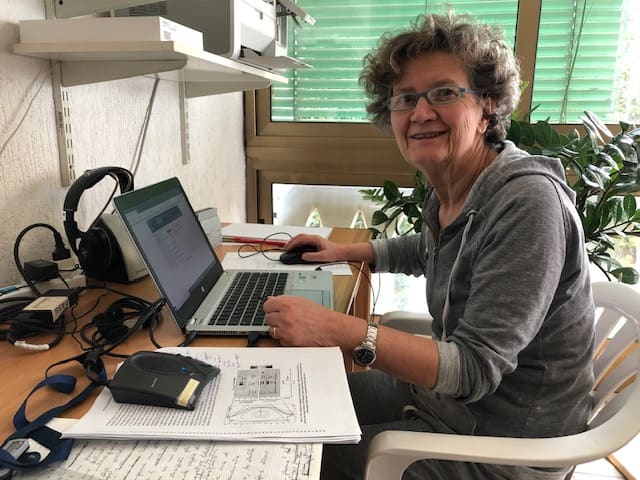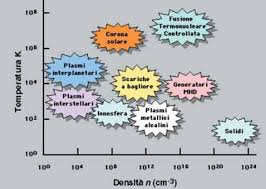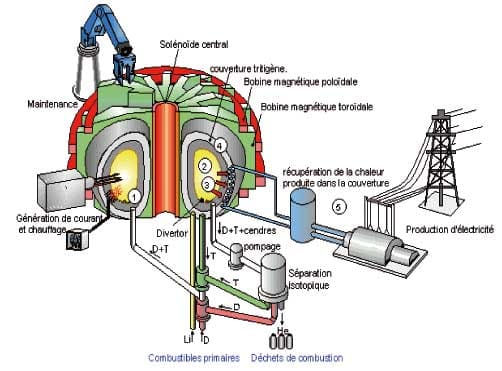Would you like to know the secrets of FUSION ?
Join us on a brief voyage into the CENTRE OF THE SUN
Could fusion become a CLEAN, SAFE, ABUNDANT and SUSTAINABLE SOURCE OF ENERGY, able to help meet the growing energy needs of the next decades?
What is meant by the term nuclear fusion and what are the scientific and technological challenges that still await us in order to reach the production of electric energy from fusion as soon as possible?
Maria Ester Puiatti, physicist and CNR researcher at Consorzio RFX,
explains what is plasma in this brief video.
WATCH our short educational videos “Science break” or SUBSCRIBE to our YouTube channel.
About 68% of the universe consists of dark energy, 27% is dark matter and only around 5% is actually visible or “known” matter. Of that 5% visible matter that we can see in the sky, from stars to galaxies, 99% is in the form of plasma. The Sun and all the stars are HUGE BALLS OF PLASMA.
When we talk about the states of matter we commonly think of one of the first three: solid, liquid or gas. A PLASMA is produced when thermal energy (heat) is applied to a gas and raises the temperature, for example by passing an electric current through it.
An example of the progression of these states is: we heat solid ice it turns to liquid water, we heat water it turns to a steam gas, we further heat steam and we get a H2O plama.
SOLID – LIQUID – GAS – PLASMA
Plasma is known as the 4th state of matter, which can be imagined as an ionized or “electrified” gas, where some or all of the molecules have been energized to the point that some of their electrons are liberated from the nuclei. A plasma is therefore a mix of free electrons, neutral particles, and positive ions, all moving in a chaotic way but with some very interesting collective processes that combine fluid mechanics with electromagnetic field interactions.
Apart from the stars, some examples of plasmas are lightning, the auroras, fluorescent lights and neon signs.
Plasma is a gas in which, by raising the temperature, some atoms are stripped of electrons, producing a mixture of neutral atoms, negatively charged electrons and positively charged ions.
– Maria Ester Puiatti

An interview with Maria Ester, fusion scientist.
Maria Ester collaborates on the RFX experiment, one of the many experiments in the world made to explore the possibility of obtaining energy from fusion processes.
– Hi Maria Ester, when did you realize that you would have dedicated your career to the study of plasma and fusion?
“Since the time of my degree thesis, I have been fascinated by the efforts that the whole international community has already made for the exploitation of this energy source“.
– And then you immediately found yourself in the experimental rooms of fusion devices such as the RFX machine in Padua. Can you tell us how energy is obtained from these fusion processes?
“It comes from the collision of ions, in particular of hydrogen and its isotopes, that is, particles that have a positive charge. Their collisions produce different ions, helium, and an enormous amount of energy. The ions have a positive charge and we must therefore use a lot of energy to be able to overcome their electromagnetic repulsion of each other to make the collisions happen.”
Why is it so interesting to study plasma, and what are the advantages of research on the fourth state of matter?
PLASMA has a very important feature: it is made of ions and electrons IN MOVEMENT, which respectively have a positive and negative charge, and electric fields flow everywhere, bringing the plasma particles to bounce against each other. This means that, even at a distance, the particles are affected by their mutual electric fields. Plasma is a very lively ionized gas.
This excitation is linked to the high thermal energy necessary to ionize the atoms. It therefore requires that the gas be confined IN VACUUM because the open air would collide with and cool the plasma, ions and electrons would recombine into neutral atoms returning the plasma to the gaseous state.
In the vacuum of outer space most of the gas is in the form of plasma, it is the key state of being for stars, gas nebulae and entire galaxies.
On earth, the atmosphere limits our ability to observe plasma in nature to a set of small but incredible phenomena: the flash of a lightning bolt in the sky or the soft color pattern of the Northern Lights. But there are also man-made plasmas in common use, for example the fluorescent tubes of a neon light or the pixels of a plasma screen TV.
So while we can easily be around some plasmas like neon lights, the plasmas that exist inside stars are much too much for us to handle up-close. So what’s the difference?
Plasma is linked to the presence of very high temperatures, millions of degrees, when the gaseous atoms have a greater chance of colliding with each other, and stripping their bound electrons off each other due to the speed of their motion.
Temperature and speed are strictly correlated: the higher the level of vibration of the atoms in an object, the higher the temperature. This is how a microwave heats food, by targeting and vibrating the water molecules inside. And so when a gas is heated, the atoms move around the equilibrium position (vibrate) with a speed that increases as the temperature increases. The higher the speed of this motion, the more likely collisions that lead to stripping electrons from atoms become.
But be careful! When we talk about very high temperatures, it does not necessarily mean that we are talking about very high heat.
If we measure the temperature of the electrons inside a fluorescent neon tube we will find about 20,000 °C, but if we touch the neon tube we won’t burn our fingers. Why is that?
Because the density of the electrons inside the tube is much lower than the density of a gas at atmospheric pressure and the amount of heat transported to the glass wall by the particles hitting it with their thermal velocity is relatively small, simply because there are so few particles inside in the first place (relative to open air).
The density of the plasma is one of its characteristic parameters, together with the temperature, and is expressed as the number of particles per cubic meter (m-3).
Density and temperature determine the different types of plasma. HOW MANY TYPES OF PLASMAS ARE KNOWN? They range from the sun and interstellar gas clouds, to neon lamps and industrial arc welders. The manifestations of plasma in nature are lightning and the northern lights.

Here are the typical densities and temperatures of some common plasmas
Let’s look at the plasma more closely, observing one of its fundamental properties: a plasma is a set of charged particles which, however, remains neutral overall.
“The comparison that is often used is to imagine a pink jelly, which inside contains jelly particles that are individually red and white, but which the eye perceives as a whole as pink. Just as in jelly, there is a minimum spatial distance for which it is possible to see the red and white particles as separate, so in the plasma there is a spatial scale at which electrons and ions move independently: this minimum distance is called the Debye length.” (cit. Wikipedia)
The effect of this property makes PLASMA MORE LIKE A FLUID than an ordinary gas.
This relates to collisions, the third and final characteristic that an ionized gas must have to be called a plasma. If the charged particles collide too frequently with neutral particles it means that the movement is not controlled by electromagnetic forces, as occurs in the case of exhaust gas from a jet engine which is a weakly ionized gas. The plasma must therefore have relatively few neutral particles in order to be controlled by electromagnetic forces. In an ionized gas (plasma) the frequency of collisions with neutral atoms is very low and the interactions between the particles are electromagnetic.
Moving from plasmas in nature to research on fusion in the laboratory, in order to reach the extremely high temperatures needed for fusion the plasma must be contained inside a vacuum chamber, but it can’t be allowed to touch the chamber walls and cool down/cause damage to the wall material, therefore we need to achieve thermal insulation between the plasma (the energized matter) and its container. One way to achieve this is to use MAGNETIC FIELDS.
The hot plasma is enclosed in the vacuum chamber, and a suitable configuration of magnetic fields (produced from the outside or from currents circulating in the plasma itself) creates a magnetic barrier between the plasma and the vessel walls. This is known as MAGNETIC CONFINEMENT FUSION.
Current machines use different types of magnetic configurations (i.e. different shapes and directions of the magnetic barrier), among them in particular are configurations called Tokamak and Reversed Field Pinch (RFP). A magnetic confinement experiment in Reversed Field Pinch (RFP) configuration called RFX-mod has been operating in Padua for several years.
An alternative path to fusion is the so-called inertial fusion: the plasma is produced by a very high power laser pulse directed on an initially solid target, heating it and compressing it to very high density values for a very short time. However, all of our research done at RFX is geared towards the magnetic confinement path.
Let’s first take a quick look at how FUSION RESEARCH was born
FROM THE FIRST STEPS IN THE 1950s, TO ITER
Modern plasma physics began in the early 1950s , after seeing the power of the hydrogen bomb it was proposed to try to adapt and control this process to generate energy from inside a fusion reactor. In 1958, a conference was held in Geneva, ATOMS FOR PEACE, designed to be a cornerstone of international cooperation, during which the participating nations revealed their program for controlled fusion – until that point the information had been classified. Research progressed over the years in the various countries with the realization of national experiments with varying designs and magnetic configurations, always advancing the dimensions and parameters, until 2007 when the agreement for ITER was reached.
ITER stands for International Thermonuclear Experimental Reactor, currently being built in France, the first experimental fusion reactor born of worldwide collaboration of 7 major world powers: The European Union, China, South Korea, Japan, India, Russia and the United States of America. The word ITER in Latin means “the way”, and it is the path that humanity must take to address the problem of eco-sustainable energy production within the second half of this century. Of all the fusion “magnetic bottles” presented in 1958, the TOKAMAK is the most mature fusion reactor model in terms of research and understanding, and is the configuration that will be used for the ITER experimental fusion reactor. The first plasma in ITER is expected in 2025.
Let’s imagine the tokamak as a doughnut shaped fusion machine that uses heavy hydrogen (Deuterium) and Tritium as fuel.
Deuterium exists abundantly in nature, it is an isotope of hydrogen and is extracted from sea water (1 part out of about 6000).
La combustione del motore della nostra macchina, il tokamak, avviene per reazioni di fusione tra atomi di DEUTERIO (che viene indicato con la lettera D) e TRIZIO (che viene indicato con la lettera T). As the burning of gasoline is the source of power in a typical car engine, the combustion that occurs in a tokamak occurs by fusion reactions between atoms of DEUTERIUM (abbreviated to the letter D) and TRITIUM (abbreviated to the letter T).
To start the reactions of D and T it is necessary to ionize the gas (i.e. turn the DT gas fuel into a plasma), bringing the plasma to temperatures well above 100 million ° C (10 kiloelectron volts – KeV) so that enough ions are free to circulate and initiate collisions for a sufficient period of time.
Being able to heat and contain the plasma at such high temperatures is the great scientific and technological challenge of research on controlled thermonuclear fusion.
But let’s go back to our fusion machine and enter a large donut-shaped chamber where, by igniting the plasma, or inducing an electric current, the light atoms of Deuterium will fuse to produce an enormous amount of energy.
But let’s first take a step inside our giant fusion doughnut, were our D+T plasma particles collide at high speed to create energy.
Conceptually, the idea is simple:
we need our hydrogen atoms to collide and fuse together
The trick however is that these D and T ions all have a positive charge, and as we know that while opposite charges attract, particles that have the same electric charge do not want to join and tend to repel each other due to the electromagnetic force, as happens between the poles with the same sign of two magnets.
This electromagnetic force repulsion is very strong and the resistance between two positive ions gets even stronger the closer together they get. However, there is an even stronger force of attraction called the nuclear force which occurs when the two particles are extremely close together. So there is a tipping point of closeness, where the very strong electromagnetic repulsion gets overwritten by the super strong nuclear attraction (about 100 times stronger). This nuclear force attraction is what causes fusion.
But how do we get to this fusion tipping point? If the ions are slow then the collisions they have will be dominated by the repulsion of the electromagnetic force, which we can imagine as a protective bubble that deflects the particles away before they can touch. Therefore, essentially we need to speed up the plasma ions until they become so fast that when they collide they break through the electromagnetic repulsion bubble and smash directly into each other at which point the nuclear force can fuse them together.
As we have seen before, to increase the speed of the plasma ions we need to increase the temperature. A lot.
The plasma contained in the vacuum chamber must be heated to approximately 150 million °C to start the fusion process.
To achieve the extreme temperatures required for fusion is a crucial technological and industrial challenge that must be developed and tested.
Let’s watch this short video together that explains what happens in the fusion processes and the technological solutions identified to create the first experimental ITER fusion reactor
Being made up of electrical charges, the plasma can be shaped by magnetic fields, and this is a very important feature that helps us to keep the plasma at 150 million ° C.
Magnetic fields contain the plasma, confining it in a donut shape suspended away from the walls of the vacuum chamber.
This is necessary both in order not to cool the plasma by conduction and to preserve the walls of the vacuum chamber as there are no physical materials that could confine a fusion plasma and directly withstand such extreme temperatures.
The magnetic fields act as non-material walls for the plasma and this is why we speak of controlled thermonuclear fusion in magnetic confinement reactors.
Let’s journey inside the heart of a magnetic confinement fusion reactor.
All around us immense magnets and superconducting windings induce electric currents that flow without encountering any resistance, avoiding dissipating energy. The donut-shaped vacuum chamber is surrounded by these magnets, in a large magnetic “hug” that prevents the plasma from touching the inner walls.
With the plasma confined and suspended in the vacuum it can now begin to release the energy produced by the fusion reactions.
The heat, transported, in the form of kinetic energy, by the neutrons produced by the fusion reactions, is deposited in the chamber wall that surrounds the plasma. Here the heat is extracted, according to the classic design of thermoelectric plants, using the heating of the cooling water, the generation of steam and the conversion into electricity through a turbine and an alternator, which will be fed into the network.

Energy is like oxygen for life.
As long as there are human beings on Earth, we need energy.
One of the best thing to do, is to replicate what happens in the Sun.
Humanity needs energy which is free of carbon dioxide emissions, safe, abundant and environmentally friendly. An energy for everyone.
We support fusion research and the efforts of scientists around the world to make it possible.